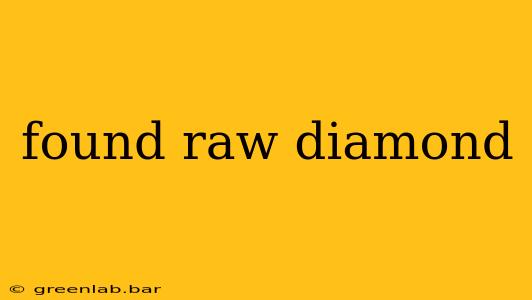Finding a raw diamond is an incredibly exciting event, a once-in-a-lifetime discovery for most. But the thrill of the find is only the beginning. What you do after discovering a raw diamond is crucial, impacting its potential value and your legal standing. This guide details the essential steps to take after your lucky find.
Identifying Your Discovery
Before you get carried away celebrating, it's vital to confirm you've actually found a diamond. Raw diamonds aren't always sparkly and easily recognizable. They can appear dull, cloudy, or even resemble other stones. Several characteristics can help you determine if your find is truly a diamond:
Key Characteristics of Raw Diamonds:
- Hardness: Diamonds are the hardest naturally occurring substance. Try scratching it against glass. If it scratches the glass, it's a strong indication it might be a diamond. Caution: This test shouldn't be considered definitive.
- Luster: While raw diamonds may not sparkle like cut diamonds, they should possess a distinctive glassy or greasy luster.
- Cleavage: Diamonds have perfect cleavage, meaning they break along specific planes. Examine it carefully for any clean breaks.
- Specific Gravity: Diamonds are relatively dense. If it feels heavier than you'd expect for its size, it could be a diamond. This requires some experience to judge accurately.
Disclaimer: These are preliminary tests. A definitive identification requires professional gemological assessment.
What to Do Immediately After Finding a Raw Diamond
-
Secure the Location: Note the exact location where you found the diamond. This is crucial for any future legal claims or property rights. Use GPS coordinates if possible. Take photographs of the surrounding area.
-
Protect the Diamond: Handle it carefully to avoid damaging it. Wrap it in a soft cloth and store it in a secure container. Avoid contact with abrasive materials.
-
Document Your Find: Take clear, well-lit photos of the diamond from multiple angles. This will help in future identification and valuation.
-
Do Not Clean It: Resist the urge to clean or polish the diamond. Any alteration could affect its value and make professional assessment difficult.
Seeking Professional Appraisal and Authentication
Once you've secured your find, it's imperative to have it professionally assessed by a reputable gemologist. A qualified gemologist can:
- Confirm its authenticity: They will use specialized equipment to determine if it's genuinely a diamond and its quality.
- Assess its carat weight: This is a critical factor in determining value.
- Determine its clarity and color: These properties significantly impact a diamond's value.
Only after a professional assessment can you understand your diamond's true value and potential.
Legal Considerations and Property Rights
Depending on where you found the diamond (private property, public land, etc.), the legal ownership might vary significantly. Research your local laws regarding mineral rights and treasure trove laws. In some jurisdictions, you might need to report your find to authorities. Consulting with a lawyer specializing in mineral rights is highly advisable.
Selling or Keeping Your Diamond
After a professional evaluation, you can decide whether to sell your diamond or keep it. If you choose to sell, research reputable diamond buyers and compare offers. Consider consulting with a jewelry appraiser who can provide insights into its potential market value. Selling a raw diamond can be a complex process, so due diligence is vital.
Finding a raw diamond is a remarkable experience. By following these steps, you can navigate the process responsibly and make informed decisions about your valuable discovery. Remember, professional expertise is essential at every stage.

